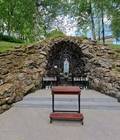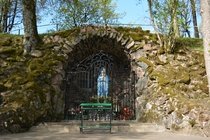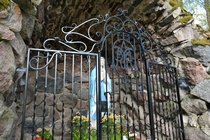 On the seafront of Plungė “Sea”, next to the gymnasium, Lourdes is built. We should be grateful for Plungė's Lurdes to the wife of the last governor of Plungė, Mykolas Mikalojus Oginskis, - Maria Skuzhevska-Oginskienė. In 1903, she invited a nun Sophia Zakiewski from the Congregation “Sisters of the Sacred Heart of Jesus“, from Krakow to Plungė who lead the girls' shelter. The leader of the congregation from France, Mari de Grand, has also visited Plungė more than once. She told the pastor of the parish thatshe wants to build a Lourdes grove in Plungė. Together with pastor V. Jarulaitis they chose a suitable place near Babrungas. M. Oginskienė donated 5000 rubles and V. Jarulaitis bought a plot of about 2 hectares near Babrungas. In 1905, S. Zakiewski brought the Holy Virgin Mary statue from Paris to Plungė's Lourdes, as a present from the leader of congregation. On October 30th, 1905 the statue was built on a stone in the open-air. In 1906, laying rocks in the river's crust began. Whereas there were lack of money, the donation box was left. The rock was completed from the donations and the Holy Virgin Mary statue was placed there. Lourdes was hollowed in 1906.
On the seafront of Plungė “Sea”, next to the gymnasium, Lourdes is built. We should be grateful for Plungė's Lurdes to the wife of the last governor of Plungė, Mykolas Mikalojus Oginskis, - Maria Skuzhevska-Oginskienė. In 1903, she invited a nun Sophia Zakiewski from the Congregation “Sisters of the Sacred Heart of Jesus“, from Krakow to Plungė who lead the girls' shelter. The leader of the congregation from France, Mari de Grand, has also visited Plungė more than once. She told the pastor of the parish thatshe wants to build a Lourdes grove in Plungė. Together with pastor V. Jarulaitis they chose a suitable place near Babrungas. M. Oginskienė donated 5000 rubles and V. Jarulaitis bought a plot of about 2 hectares near Babrungas. In 1905, S. Zakiewski brought the Holy Virgin Mary statue from Paris to Plungė's Lourdes, as a present from the leader of congregation. On October 30th, 1905 the statue was built on a stone in the open-air. In 1906, laying rocks in the river's crust began. Whereas there were lack of money, the donation box was left. The rock was completed from the donations and the Holy Virgin Mary statue was placed there. Lourdes was hollowed in 1906.
1909-1910 priest V. Jarulaitis built a wooden Gothic chapel over Lurdes, and M. de Grand gave a white marble altar as a present.
In May of 1928 Bishop Justinas Staugaitis gave Plungė's Lurdes to monks Capuchins. There was no Capuchin monastery in Lithuaniauntil the 20th century, only individual monks acted here.
In Soviet times, Lurdes of Plungė was destroyed, the statue of Holy Mary was smeared out and thrown into Babrungas River. People who found her, brought her to the church of Plungė.
The restored Lourdes of Plungė with the copy of Holy Virgin Mary sculpture was solemnly sanctified in 1990, on October 20th. The old sculpture remained in the Church of Plungė. During the course of the nineteen years of independence, Lourdes did not recover the aura of the exclusive sacred space – vivid, constricting many pilgrims, and this was until the Second World War. However, between years 1936-1939, congresses of sick at Plungė's Lurdes hosted crowds.

+4





Reviews